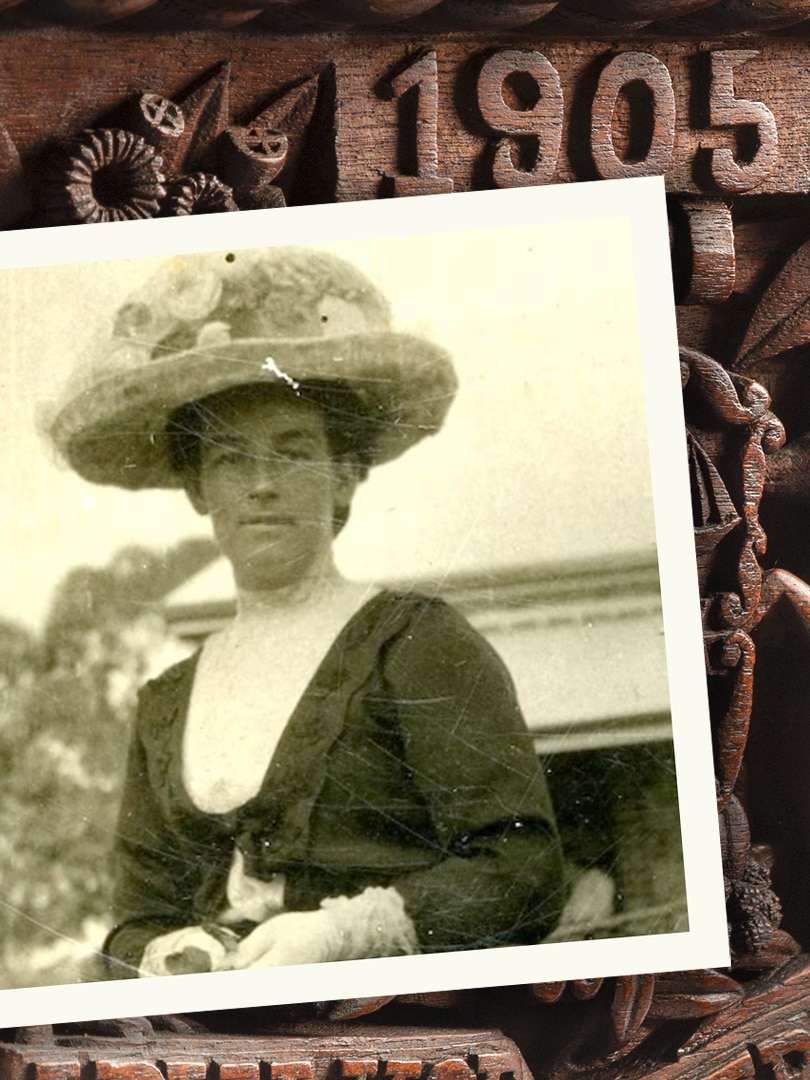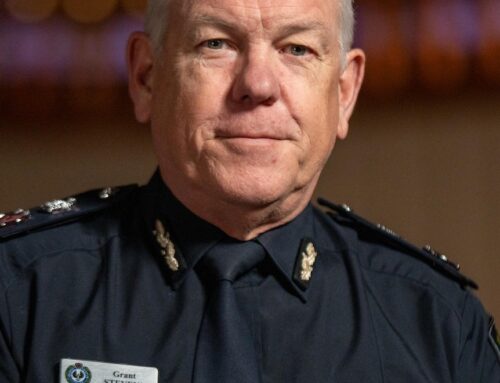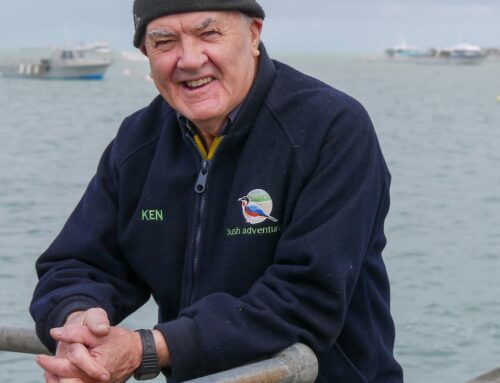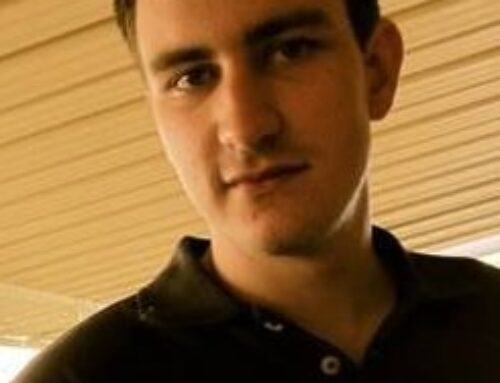Port Lincoln’s Bill Lakin fondly remembers his grandmother, Ma-ma, as a humble, frail lady in a wheelchair, who had scrapbooks of paintings and drawings.
That this unassuming elderly woman was also one of the most intriguing female woodcarvers in the nation’s history is a source of family pride.
And what’s most extraordinary about Maud Baillie is that she created most of her intricate pieces of carved wooden furniture while still in her teens and early 20s.
Woodcarver Maud Baillie (nee Golley). (Supplied: Betty Lakin Collection)
This week the Art Gallery of South Australia unveiled a glass cabinet Maud carved in 1905, at the age of 21, when she was living on remote Wedge Island, off the South Australian coast.
Artlab Australia conservator Justin Gare spent a year restoring the glass cabinet. (Supplied: Art Gallery of South Australia)
The cabinet has been described as a “unique Australian art piece”.
Unique also aptly describes Maud’s own story, which is one of true inspiration.
Island horse breeders
Maud Golley, as she was then known, grew up on Wedge Island helping her family breed British Indian Army remount horses.
Horses bred by the Golleys for the British East Indian army were swum out to ships and hoisted aboard with a sling. (Source: State Library of South Australia, B-76452)
Wedge Island is located near the entrance to Spencer Gulf.
The family produced food for themselves and crews of passing ships, and also kept the island lighthouse maintained.
In the evenings, as a teenager, Maud taught herself woodcarving using rudimentary tools her father made.
She created rich imagery of the island, carving designs depicting rope, goat’s wool, shells, grape vines, flowers and plants into pieces of driftwood and, later, blackwood that she shipped from England.
She made and used wooden pegs, instead of nails and screws, to make furniture.
The Golleys lived on Wedge Island from the late 1800s, farming goats and growing vegetables. (Source: State Library of South Australia)
Mr Lakin’s family sold six pieces made by Maud to the art gallery in 2019.
“They’re now there for everyone to see,” an emotional Mr Lakin said of his grandmother’s work.
Maud Baillie’s grandson Bill Lakin is proud her work is being recognised. (ABC Eyre Peninsula: Jodie Hamilton)
“The cabinets that she’s made, you’d never see them again in your lifetime.”
He said his Ma-ma would never have dreamed her creations would be in the state’s premier art gallery or recognised for their place in the nation’s art history.
“She’s got carving and artwork everywhere and she said to mum one day, ‘Oh, they’re only pieces of wood, Betty’,” Mr Lakin said.
Maud Baillie’s chiffonier and chair have been on display at the Art Gallery of SA since 2019. (ABC News: Brant Cummings)
‘Completely original, fabulous’
Artlab Australia senior objects conservator Justin Gare spent more than a year replicating just one section, a rope piece featured on the bottom of the highly decorative glass cabinet, that was missing.
Mr Gare said Maud’s work forged the first truly Australian designs at a time when furniture and art imitated English or European styles.
Art critics have praised Maud Baillie’s rich unique Australiana imagery. (ABC Eyre Peninsula: Jodie Hamilton)
The Golleys maintained the lighthouse on Wedge Island, named by explorer Matthew Flinders for this huge cliff. (ABC Eyre Peninsula: Jodie Hamilton)
“We’re talking about a girl who’s barely 20, no technical training, no books, no references — it’s all coming out of her head,” Mr Gare said.
“She’s completely unique, even on a world stage.
“You’re used to seeing pieces which have been emulated or that are in fashion, whereas she’s going out on a limb and doing what she wants to do.
“It’s completely original, its fabulous — bizarre.
“It wouldn’t surprise me if she’d taken a whole year to do this piece — she must have been working every night.”
The gallery’s crafts curator, Rebecca Evans, said while it was common for women to pursue crafts in the early 1900s, Maud’s work stood out.
Maud Baillie’s autograph diary featuring the bows and ropes she also used in her carvings. (ABC Eyre Peninsula: Jodie Hamilton)
Maud Baillie’s family have photographs from her life on Wedge Island. (ABC Eyre Peninsula: Jodie Hamilton)
“Women produced amazing things and it’s great that we are finally recognising these artists … and their contribution to art history,” Ms Evans said.
Maud was inspired by images she saw on her island home but her pieces also reflected a connection to the world and Australia’s federation — the coat of arms, lions, and often the date featured prominently in her work.
Governor’s gift
It was thought Maud carved with just a pocketknife, but Mr Gare said that was a myth because it was not possible to do the fine-quality carvings and cutting detail with such a tool.
Researcher Jo Vandepeer, who completed her doctorate on South Australia’s female woodcarvers, said Maud’s talent was discovered in 1904 by South Australian governor George Le Hunte.
Some of the tools Maud Baillie used to carve her furniture. Experts say it is a myth she carved with just a pen knife.
The governor was visiting Wedge Island to shoot quail with a group of friends, many of whom had wives who were also keen woodcarvers, as the pursuit had gained popularity among women in the early 1900s.
But he was particularly impressed with Maud’s creations, and arranged for two of her pieces to be exhibited in Adelaide and Melbourne in 1907.
“They were surprised by ‘the crude and odd lot’ of tools she used so they organised for her to be presented with a beautiful set in a velvet-lined case,” Ms Vandepeer said.
According to family members, she never used the finer tools and continued carving with her own knives.
Proud family
Maud’s granddaughters, Pauline and Jenny, have some tools and photobooks from their grandmother’s time living on Wedge Island.
“For us as a family, it’s immense pride that this amazing woman who would have had a very difficult life, as did many pioneers in early South Australian life, lived in an isolated location but managed to produce this piece of work,” Pauline said.
“Most of her pieces have been done in her late teens to her early 20s.
Art Gallery of South Australia crafts curator Rebecca Evans with Maud Baillie’s granddaughters, Janet and Pauline. (ABC News: Brant Cumming)
“She was a farmer’s wife and she didn’t carve anything after she was married [to Stuart Baillie in 1924].”
Ms Evans said Maud’s work showed the importance of craft to the world of art.
“Over the last 40 years … those crafts have died out with, particularly, women entering the workforce,” Ms Evans said.
“People like Maud Golley, 100 years ago, were producing amazing work just in their living rooms.
“I hope that inspires people to make — and not be worried about what it might look like — but just to continually always create.”
Ms Vandepeer said Maud had gone on to live a relatively introverted life.
“I was particularly sad when her daughter told me that she made extra money from selling handmade lollies on the side of the road, when her talent suggested a different trajectory altogether,” she said.
More than a century after Maud picked up a knife and started whittling, her family is proud that her extraordinary work is being recognised and is on permanent display for all to see.




